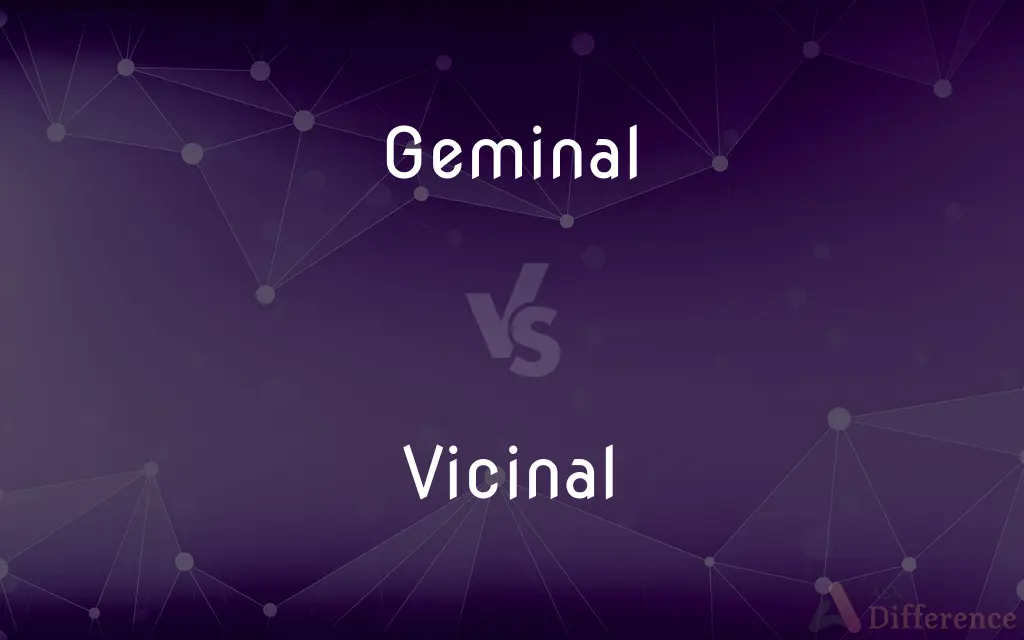Geminal vs. Vicinal — What's the Difference?
By Fiza Rafique & Maham Liaqat — Updated on April 7, 2024
Geminal dihalides contain two halogen atoms on the same carbon atom, while vicinal dihalides have halogens on adjacent carbons, showcasing their distinct structural arrangements in organic chemistry.

Difference Between Geminal and Vicinal
Table of Contents
ADVERTISEMENT
Key Differences
Geminal dihalides are characterized by the presence of two halogen atoms attached to the same carbon atom within a molecule, indicating a specific structural feature in organic compounds. This configuration can influence the chemical reactivity and physical properties of the compound. Vicinal dihalides, on the other hand, have their halogen atoms on adjacent carbon atoms, which creates a different set of chemical behaviors and reaction pathways due to the spatial arrangement of the halogens.
The term "geminal" comes from the Latin "geminus," meaning "twin," reflecting the twin halogens on a single carbon. This arrangement can lead to unique interactions between the halogen atoms due to their proximity, affecting the molecule's overall stability and reactivity. Conversely, "vicinal" is derived from the Latin "vicinus," meaning "neighboring," which aptly describes the placement of halogens on neighboring carbon atoms, influencing the compound's chemistry through the potential for interactions across the carbon-carbon bond.
Geminal dihalides are often involved in reactions that exploit the closeness of the two halogens, such as nucleophilic substitutions or eliminations, leading to various organic synthesis pathways. Vicinal dihalides are key intermediates in several important organic reactions, including the formation of alkenes through dehalogenation, showcasing their utility in constructing different types of chemical bonds and structures.
Studying geminal and vicinal dihalides offers insights into how the arrangement of atoms within a molecule can dramatically affect its chemical properties and reactivity. This distinction is crucial for chemists designing synthetic routes for complex molecules, where the choice between a geminal or vicinal arrangement can dictate the success of the synthetic strategy.
Both geminal and vicinal dihalides play significant roles in organic chemistry, not only in the synthesis of complex molecules but also in understanding fundamental concepts of chemical reactivity and molecular structure. Their study exemplifies the importance of molecular geometry in determining the path and outcome of chemical reactions.
ADVERTISEMENT
Comparison Chart
Halogen Location
Two halogens on the same carbon atom
Halogens on adjacent carbon atoms
Derived From
Latin "geminus" (twin)
Latin "vicinus" (neighboring)
Chemical Reactivity
Influenced by proximity of halogens
Affected by the spatial arrangement of halogens across a carbon-carbon bond
Common Reactions
Nucleophilic substitutions, eliminations
Dehalogenation, formation of alkenes
Structural Influence
Can affect stability and reactivity due to closeness of halogens
Interactions across carbon-carbon bond affect reactivity
Importance in Synthesis
Useful for specific synthetic pathways due to close halogen interaction
Key intermediates in forming different chemical structures
Compare with Definitions
Geminal
Can lead to the formation of various organic compounds.
Geminal dihalides are precursors to alcohols and ethers.
Vicinal
Affects the chemistry of neighboring carbon atoms.
The presence of vicinal dihalides facilitated the rearrangement reaction.
Geminal
Compounds with two halogens on the same carbon atom.
The geminal dibromide was a key intermediate in the reaction.
Vicinal
Molecules with halogens on adjacent carbon atoms.
The vicinal dichloride was easily converted to an alkene.
Geminal
Plays a role in nucleophilic substitution reactions.
The reaction proceeded through a geminal dihalide intermediate.
Vicinal
Essential for dehalogenation reactions to form alkenes.
Vicinal dihalides undergo dehalogenation to yield alkenes.
Geminal
Influences molecular stability and reaction pathways.
Stability issues in geminal dihalides prompted an alternative synthesis route.
Vicinal
Serve as intermediates in organic synthesis.
The synthesis utilized a vicinal dihalide to construct the carbon skeleton.
Geminal
Known for their unique reactivity due to halogen proximity.
Geminal dihalides are often used in synthesizing ketones.
Vicinal
Involved in creating vicinal diols through hydrolysis.
Hydrolysis of the vicinal dihalide produced a diol.
Geminal
In chemistry, the descriptor geminal refers to the relationship between two atoms or functional groups that are attached to the same atom. The word comes from Latin gemini meaning "twins".
Vicinal
Neighbouring; adjacent.
Geminal
Denoting substituent atoms or groups, especially protons, attached to the same atom in a molecule.
Vicinal
(of a railway or road) serving a neighbourhood; local.
Geminal
(chemistry) Describing identical atoms or groups attached to the same atom in a molecule
Vicinal
Of, belonging to, or restricted to a limited area or neighborhood; local.
Geminal
A pair.
Vicinal
Relating to or being a local road, especially one in ancient Britain.
Vicinal
(Mineralogy) Approximating, resembling, or taking the place of a fundamental crystalline form or face.
Vicinal
(Chemistry) Of or relating to the consecutive positions on a ring or chain of carbon atoms.
Vicinal
Of or pertaining to a neighborhood; neighboring.
Vicinal
(chemistry) Describing identical atoms or groups attached to nearby (especially adjacent) atoms in a molecule.
Vicinal
(mineralogy) Describing subordinate planes on a crystal, which are very near to the fundamental planes in angles, and sometimes take their place.
Vicinal
Near; vicine.
Vicinal
Having the substituted groups on the same carbon atom.
Vicinal
Belonging to or limited to a vicinity
Common Curiosities
What distinguishes geminal from vicinal dihalides?
Geminal dihalides have both halogens on the same carbon, while vicinal dihalides have halogens on adjacent carbons.
Can the placement of halogens affect the stability of dihalides?
Yes, the placement significantly influences stability; geminal dihalides might be less stable due to the strain from having two halogens on the same carbon.
How does the presence of geminal dihalides influence reaction mechanisms?
Their presence can dictate specific nucleophilic substitutions or elimination reactions, based on the halogens' proximity.
Why are geminal dihalides important in organic synthesis?
They offer unique reactivity due to the proximity of halogens, useful in various synthetic pathways.
How do vicinal dihalides participate in chemical reactions?
Vicinal dihalides are crucial for reactions like dehalogenation and serve as intermediates in synthesizing other organic compounds.
What are the challenges in using geminal dihalides in synthesis?
Managing their reactivity and potential instability can be challenging in complex synthesis routes.
How are vicinal dihalides synthesized?
They can be synthesized through various methods, including adding halogens to alkenes.
Can vicinal dihalides be converted into other functional groups?
Yes, they can be transformed into vicinal diols, alkenes, and other functional groups through specific reactions.
What role do vicinal dihalides play in the formation of alkenes?
They are often used as intermediates in dehalogenation reactions to form alkenes.
What impact do geminal dihalides have on molecular geometry?
The presence of two halogens on the same carbon can lead to significant changes in molecular geometry and electron distribution.
What are the common uses of geminal and vicinal dihalides?
Geminal dihalides are used in the synthesis of alcohols and ketones, while vicinal dihalides are key in producing alkenes and vicinal diols.
Are there any special considerations when working with geminal dihalides?
Yes, their potential instability and unique reactivity patterns require careful planning in synthetic strategies.
Share Your Discovery

Previous Comparison
Maximum vs. Optimum
Next Comparison
Extol vs. ExtollAuthor Spotlight
Written by
Fiza RafiqueFiza Rafique is a skilled content writer at AskDifference.com, where she meticulously refines and enhances written pieces. Drawing from her vast editorial expertise, Fiza ensures clarity, accuracy, and precision in every article. Passionate about language, she continually seeks to elevate the quality of content for readers worldwide.
Co-written by
Maham Liaqat















































